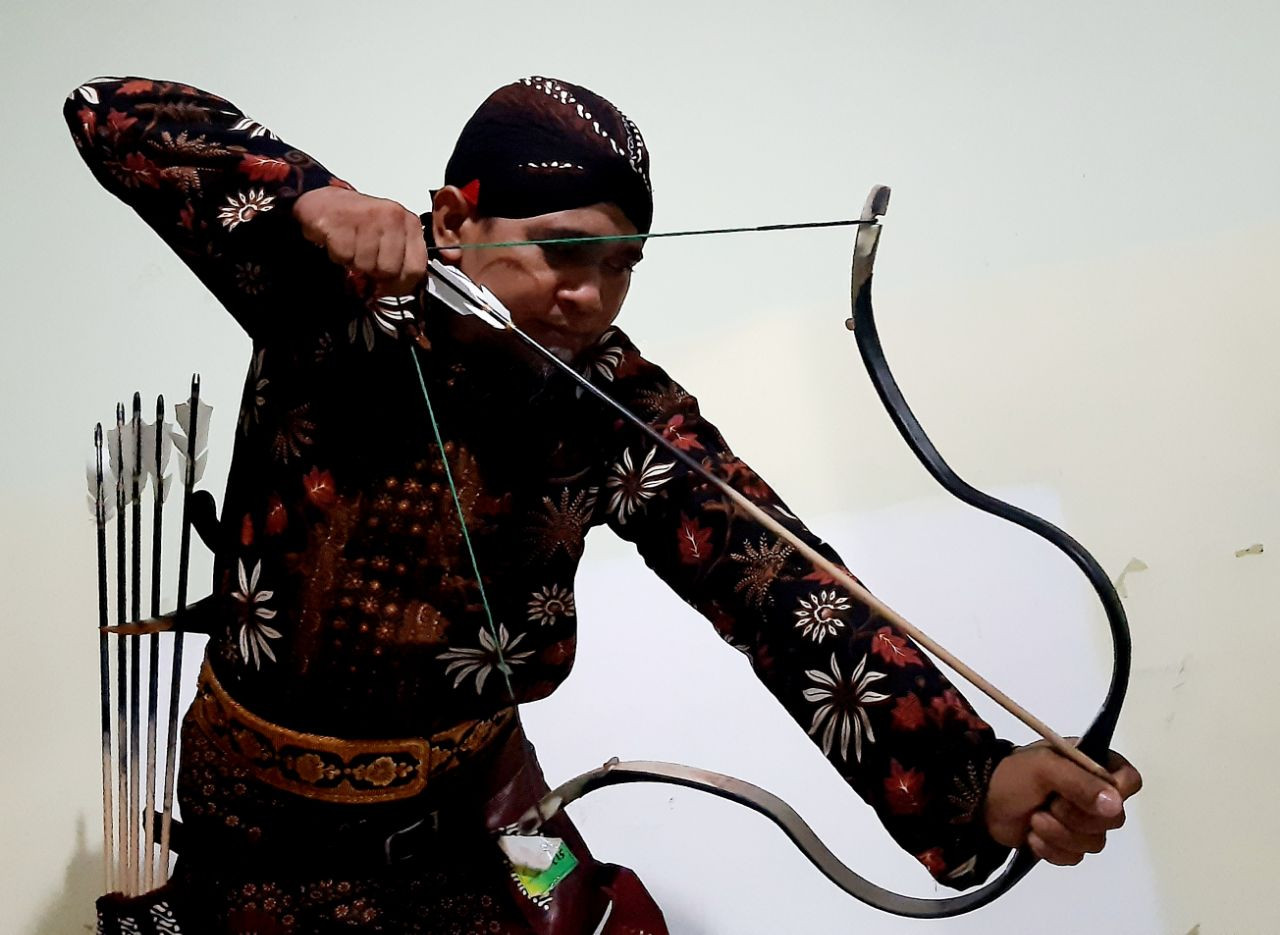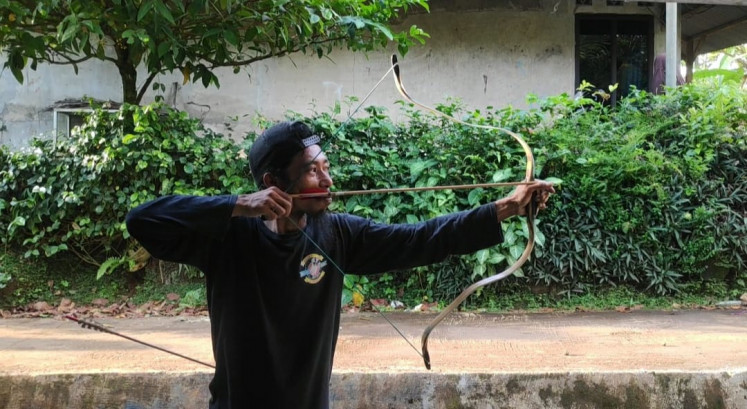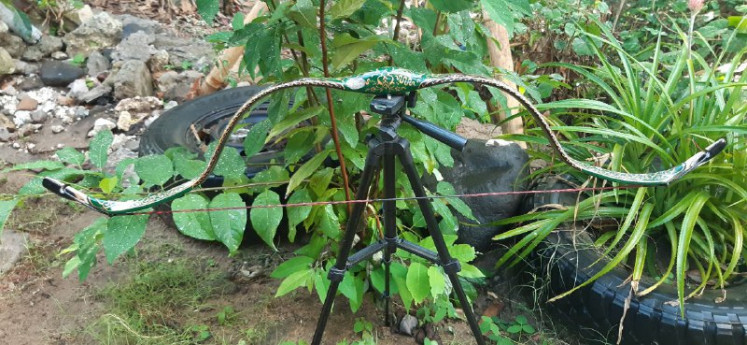Popular Reads
Top Results
Can't find what you're looking for?
View all search resultsPopular Reads
Top Results
Can't find what you're looking for?
View all search resultsMaking traditional Asiatic bows with Indonesia's bowyers
Although Indonesia is better known for its keris, kelewang, parang and other types of short daggers, many hobbyists find leisure in bow making.
Change text size
Gift Premium Articles
to Anyone
A
lthough Indonesia is better known for its keris, kelewang, parang and other types of short daggers, many hobbyists find leisure in bow making.
A growing number of Indonesians are getting into archery, and there are cultural reasons why many feel a particular attachment to the sport.
Asiatic bows are historically made using materials such as horn, bone, sinew, hide or fish-bladder glue, and bamboo or hardwood. It takes bowyers like Anwar Halimudin around six months to one year to build a horn bow using the same method and materials as in the old days.
"I take pleasure in building bows. Crafting has always been my hobby since childhood," Anwar, a 34-year-old native of Garut, West Java, said. “When I was a kid I used to make bows from bamboo. I hunted squirrels and birds on the paddy fields and fish on the fonds.
“To relive my childhood, I jumped on the bandwagon when [traditional Asiatic] archery gained popularity in [2014] and looked on the internet on how to make a horn bow. I began building one in 2017,” Anwar, who majored in fine arts, said.
However, it was not until 2020 that he began selling his works under the brand Carebows, which is a wordplay on kerbau (water buffalo), whose horns can be used to make bows. He now has two workshops, each located in Bandung and Garut.
Anwar, whose main occupation is teaching at a boarding school in Bandung, said he had recreated bows from various cultures. He insisted making a horn bow required one to exercise extra patience and determination.
"[You cannot just decide you want to make] a horn bow and expect you will succeed the first time. [Expect to] fail one, two, three, four, five, six times," Anwar said.
In action: Supri 'AJ Archery' poses with a flight-shooting Ottoman bow. (Courtesy of Supri 'AJ Archery') (Courtesy of Supri 'AJ Archery'/Courtesy of Supri 'AJ Archery')Scientists believe that horn-sinew composite bows originated in ancient nomadic cultures in the Asiatic steppe. By the fourth millennium BCE, the technology had become common in Mesopotamia and Elam. It then spread throughout Asia, Eastern Europe and North Africa.
To build a composite bow, one must first shape the core. Anwar said he used either bamboo or mulberry, with bamboo being more desirable. He will then shave a pair of horns into strips and shape them to match the core before gluing them to the belly side of the bow. Anwar said he preferred rawhide glue for his bows.
The bowyer will then hammer and comb dried sinew until it turns into fine strands, after which they are glued to the back side of the bow. After waiting for around six months to one year for the glue to cure, the bow will be ready for tilling before the bowyer covers it with leather, tree bark or lacquer.
"Those who want to learn how to build a horn bow from scratch can visit my YouTube channel, [Carebow Nusantara], on which I have posted tutorial videos," Anwar said.
Modern approach
While Anwar is known for his organic bows, modern traditional bows, made using synthetic materials, are more common in Indonesia. The most popular material is glass-fiber-reinforced epoxy resin (GRE), colloquially referred to as epoxy fiberglass (EFG). Among those who use the technology to make bows is Supri. Like Anwar, Supri said he used to hunt with a bow and arrow when he was a child.
“As an adult, I learned [traditional] archery from the internet, but the first bow I bought was a modern-compound bow,” the 45-year-old, who chose to only share his nickname, said.
Supri said he decided to retire as a furniture wholesaler in 2016 and began selling bows under the brand AJ Archery when his business underwent stagnation. His workshop is located in Jimbaran, South Kuta, Bali.
“I do not know exactly when I established the brand AJ Archery because it was a continuation of my previous trademark, AJ Furniture, back when I was still a furniture wholesaler,” Supri said.
"I joined [traditional archery] WhatsApp and Facebook groups [to learn traditional archery and how to make bows]. [Every time I posted my works, people said] they liked them. They could not make bows the way I made them, so they asked me to make some for them. That was around 2016. I have been making and selling bows since then.”
Trial: Toto 'Al-Harits' Sunarto tests a Tatar bow. (Courtesy of Toto Sunarto) (Courtesy of Toto Sunarto/Courtesy of Toto Sunarto)Supri is one of the pioneers to utilize the bow-making method referred to as "bending" in Indonesia. It comprises splitting factory-made GRE strips and gluing them back together in a way that results in desired curves. With the method, bowyers do not have to mold their own GRE to make the shapes they want.
Like Anwar, Supri also said he practiced archery as an adult to relive his childhood. “At first, I learned how to make bows because I want to do archery with my very own bows,” he said.
“Why does it have to be Asiatic bows? Because they are beautiful. I was a wood carver back in Jepara [where I came from], so I like [arts in general]. Horse bows, also known as Asiatic bows, are artistic, unlike the boring modern bows.”
Where old meets new
Anwar and Supri have also been making "hybrid" bows recently, like 34-year-old Toto Sunarto, who was one of the earliest to make such bows. Indonesian-style hybrid bows are made by adding a layer of horns to the belly of a "bending fiberglass" bow. Hybrid bows offer the durability of modern materials while maintaining the historical look and feel of a traditional bow.
“I began learning archery in 2014 from YouTube and Google,” Toto said. “I began making bows in 2015. I also learned how to make them from [the internet]. I have been selling my bows under the brand Al Harits Archery since 2016. My workshop is located in Banjar, West Java.
“I do archery because it is a sunna [prophetic example], for which [Allah rewards the practitioners]. I make bows [for the same reason].”
Toto said he used to make wooden compound bows before shifting to traditional bows. Before he began making bows, he “used to sell food”.
“However, after I learned how to make bows, I started focusing on selling them. Other than it being a hobby, it also makes more money,” he said. “Other than bows, I also make [archery] thumb gloves.”
Toto said he had never faced difficulties in making bows, but those who want to learn must be "financially stable”.
“You will fail multiple times and the materials are not cheap," he said, adding that one must be "resilient and patient" throughout the process.
Toto said he regretted the lack of support for traditional archery. He said the government needed to "[accommodate] traditional archery so there will be more people practicing [the sport]".
"I wish people acknowledged that [traditional] archery is a positive, [beneficial] and fun sport," Toto said.
Diverse: Different archery cultures use different bow designs. Pictured is 'Babur', a Mughal bow by Supri 'AJ Archery'. (Courtesy of Supri 'AJ Archery') (Courtesy of Supri 'AJ Archery/Courtesy of Supri 'AJ Archery)Similarly, Supri said he hoped that traditional archery would become more widespread and be free from stigma.
"I hope people realize that traditional archery has nothing to do with terrorism [as it is stigmatized]. I hope they can see someone carrying the bow and arrow [to the range] the same as they see people carrying a ball to the field to play soccer," he said.
"Our forefathers were archers. The function of the bow and arrow are different, of course, but I hope that people will stop seeing [traditional] archery as something strange, something scary. Traditional archery is a part of our culture. We have [Sundanese and Javanese] jamparingan, for example," Anwar added.
ohmg














